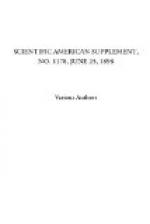Many schemes are employed for improving the load factor, or, in other words, to encourage a long use of central station product. Some companies adopt a plan of allowing certain stated discounts, provided the income per month of each lamp connected exceeds a given sum. The objection to this is that it limits the number of lamps connected. Other companies have what is known as the two-rate scheme, charging one rate for electricity used during certain hours of the day and a lower rate for electricity used during the balance of the day, using a meter with two dials for this purpose. Other companies use an instrument which registers the maximum demand for the month, and the excess over the equivalent of a certain specified number of hours monthly in use of the maximum demand is sold at greatly reduced price. The last scheme would seem particularly equitable, as it results in what is practically an automatic scale of discounts based on the average load factor of the customers. It does not seem to be just that a man who only uses your investment say 100 hours a year should be able to buy your product at precisely the same price as the man who uses your investment say 3,000 hours a year, when the amount of money invested to take care of either customer is precisely the same. Surely the customer who uses the product on an average 30 times longer than the customer using it for only 100 hours is entitled to a much lower unit rate, in view of the fact that the expense for interest to the company is in one case but a fraction per unit of output of what it is in the other. This fact is illustrated by the interest columns on the graphic chart already referred to. Supposing that the central station manager desired to sell his product at cost, that is, an amount sufficient to cover his operating, repairs and renewals, general expense, and interest and depreciation, he would have to obtain from the customer having the poorest load factor, as shown on the load chart, over four times as much per unit of electricity as it would be necessary for him to collect from the customer having the largest load factor. No one would think of going to a bank to borrow money and expect to pay precisely the same total interest whether he required the money for one month or for twelve; and for the same reason it seems an absurdity to sell electricity to the customer who uses it but a comparatively few hours a year at the same price at which you would sell it to the customer using it ten hours a day and three hundred days a year, when it is remembered that interest is the largest factor in cost, and the total amount of interest is the same with the customer using it but a few hours a year as it is with the customer using it practically all the year around.




